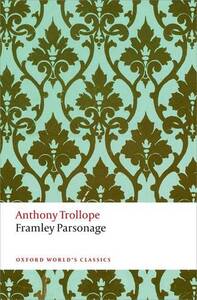
Framley Parsonage (1860) is the fourth of the Barsetshire Chronicles, and was the breakthrough novel that sealed Trollope’s success. The story was commissioned by George Smith for his new Cornhill Magazine, and he requested “an English life, with a clerical flavour.” The serialisation, with illustrations by Millais, was an immediate success, attracting 120,000 subscribers.
The story centres on Mark Robarts, a young man who is presented with the comfortable living of Framley by a friend’s mother. Although he enjoys the stability of being a clergyman, Robarts also craves the excitement of being a gentleman about town, acquiring several horses and a liveried footman for his family. After exposure to the Bohemian lifestyle at Gatherum Castle, Robarts is persuaded to sign a promissory note for Nathaniel Sowerby, a local MP with a gambling addiction and a complete lack of personal responsibility. As the debt escalates, Robarts descends further into the mire until his respectable existence is invaded by bailiffs and money lenders.
Whereas the previous chronicle in the series, Dr Thorne, featured a sensation plot, Framley Parsonage is characterised by a gently undulating and detailed narrative. Trollope apparently drew up a map of Barsetshire to ensure the accuracy of his descriptions, and it was this complexity that inspired George Eliot to write Middlemarch. The narrative does occasionally sag under the weight of this detail, and it lacks the drive of Trollope’s other work. However, the evocation of the people and landscape makes it a firm favourite with Barsetshire aficionados.
For me, the great strength of the novel is Martha Dunstable, the wealthy heiress to whom the reader was first introduced in Doctor Thorne. Having inherited £200k (squillions in today’s money) from sales of a dubious unguent called Ointment of Lebanon (perhaps an allusion to Madame Rachel’s Jordan Water?), she is a conspicuous target for impecunious suitors. Not conventionally beautiful, when a well-meaning friend points out that her curls are “not the thing,” she replies: “They’ll always pass muster when they are done up with bank-notes.”
As a 40-year-old spinster, Martha is a figure of ridicule, but she disarms her opponents by laughing at herself. She tolerates a succession of marriage proposals from importunate wastrels, letting them down firmly but gently. Content in herself, she is happy to remain single until the right man comes along, ie one who doesn’t love her just for her fortune. When she does find such a beast, she retains control of her wealth and doesn’t allow her identity to be absorbed into that of her husband. Her vivacity and sense of fun make her a refreshingly positive portrayal of a spinster, and one of Trollope’s most appealing heroines.
In terms of the story, Framley Parsonage is not among Trollope’s finest works. However, as David Skilton and Peter Miles write in their excellent and illuminating introduction, it is notable for:
the fluent and expressive style, the humour, the intelligent absorption in the essentially everyday, the tolerant analysis of conduct in the commonplace business of life; and, in addition, the moderate suspense, the ordinary and almost “approachable” characters, and the comforting sense of life going on…
Trollope’s ability to describe life as it was lived is shown at its best in Framley Parsonage. Elizabeth Gaskell was moved to write: “I wish Trollope would go on writing Framley Parsonage for ever. I don’t see any reason why it should come to and end,” and Elizabeth Barrett Browning thought it “really superb”. I did want it to end, but mainly because I have another 19 Trollopes to read.
Framley Parsonage by Anthony Trollope